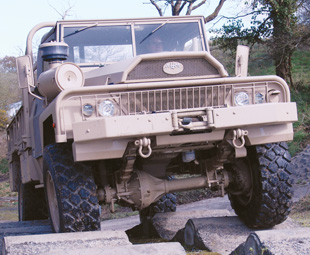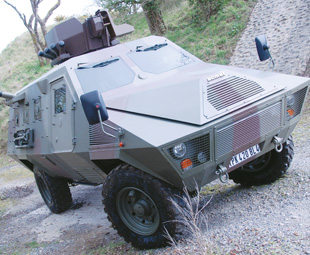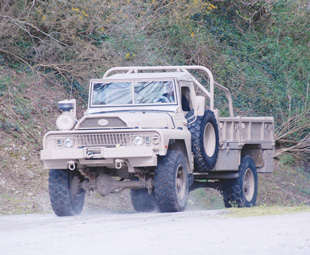No frills

A visit to the land of cheese-eating surrender monkeys courtesy of the world’s worst airline to drive the world’s toughest truck gets SHAUN CONNORS, our intrepid Brit, all excited. A little too excited in fact…
As you might expect, I was rather excited when told I was off to France to play with what anybody who knows anything about trucks acknowledges being the toughest truck in the world, ever. But the bad news? And you just know there always has to be some… To reach the facilities of Ateliers de Construction Mecanique de l’Atlantique (ACMAT), the only sensible way to travel was to fly.
Yes, I could have travelled by car/ferry and/or train, but in the time it would have taken me to cover from where I was in England to France, Michael Palin would have circumnavigated the globe, twice, on a bicycle. So flying it had to be.
Now it’s not that I don’t enjoy flying, because most of the time I do. Trouble was my only flight option was Ryanair, or as I prefer to call it, the No Service Airline. So, given a name like that you can imagine how much I might enjoy travelling with that lot. And I’m not alone in my opinions, trust me.
For the past five years Ryanair has won TripAdvisor’s prestigious award for being the UK’s least favourite airline. Okay, when flying ‘no frills’ I can cope with being stung for in-flight refreshments. However, I’m far less happy with what I’m charged for using a credit or debit card to pay for my ticket. And if you think the stunt they pulled to charge people who queued at a check-in desk was a bit much, they don’t actually do that anymore. Nope, now everybody has to check-in online. And your punishment should you turn up at the airport without your boarding pass pre-printed? Ryanair will happily charge £40 to print you one. I wonder whose idea of a bad joke that was? Probably the same numpty that decided passengers who cannot travel with a piffling 10 kg cabin baggage allowance, would be charged extra to put a bag in the hold. And let’s not forget that poor guy with cerebral palsy who Ryanair charged £18 to use a wheelchair.
 And just in case anybody thinks I’m being unfair, or perhaps on commission from competing low-fare airlines such as Easyjet or BMI Baby, just Google Ryanair. Amidst the raft of websites out there taking a pop at the ‘no service airline’ you’ll find www.ryanaircampaign.org a very interesting site Ryanair liked so much they tried to close it by obtaining the domain name. They claimed it infringed on trademarks and the site was set up in bad faith. They failed, the site is still going and should you ever visit the UK, I strongly recommend that before you even consider flying with the no frills Ryanair, you check it out.
And just in case anybody thinks I’m being unfair, or perhaps on commission from competing low-fare airlines such as Easyjet or BMI Baby, just Google Ryanair. Amidst the raft of websites out there taking a pop at the ‘no service airline’ you’ll find www.ryanaircampaign.org a very interesting site Ryanair liked so much they tried to close it by obtaining the domain name. They claimed it infringed on trademarks and the site was set up in bad faith. They failed, the site is still going and should you ever visit the UK, I strongly recommend that before you even consider flying with the no frills Ryanair, you check it out.
You could probably class an ACMAT truck as a no frills product; however its lack of frills are definitely not to the detriment of the user. Exactly the opposite in fact, and in this case a lack of frills helps ensure it does what it needs to, better and for longer.
Now I’m sure a fair percentage of readers are wondering why, if these ACMAT trucks are as good as I say they are, they’ve never seen one, especially when I add that essentially the same truck (the VLRA – Véhicule de Liaison, de Reconnaissance et d’Appui) has been in production for over 40 years.
Some oil exploration companies and many French fire brigades use ACMAT trucks, but ACMAT’s VLRA was actually designed with military users in mind. Even then it’s no ordinary truck, having been designed from scratch to operate and survive in the harshest environments on the planet. In fact, according to the company 93% of all ACMAT sales are exported, with the bulk of those sales being to places you just wouldn’t go to unless you’re one of those wooly-minded busybody do-gooder types that gets off on building mud huts for single parent mothers in some godforsaken far flung corner of the globe.
 That said, keener-eyed readers may have seen a VLRA during France’s annual Bastille Day parade, that old bald geyser that ran France (and thought he ran Europe) insisting on opening the parade in one. The French Army has some, the Irish Army had a few, and rumour has it they’re so tough that Andy MacNab’s former workmates use them. Most though are dotted around Africa, in countries run by medal-adorned self-appointed generals and places that no self-respecting South African would ever set foot.
That said, keener-eyed readers may have seen a VLRA during France’s annual Bastille Day parade, that old bald geyser that ran France (and thought he ran Europe) insisting on opening the parade in one. The French Army has some, the Irish Army had a few, and rumour has it they’re so tough that Andy MacNab’s former workmates use them. Most though are dotted around Africa, in countries run by medal-adorned self-appointed generals and places that no self-respecting South African would ever set foot.
So what makes an ACMAT so tough, so durable, so desirable then? Well, the story starts back in the early 1960s with the VCOM (Overseas Combat Vehicle), 193 of which were supplied to Djibouti between 1963-1964. Paul Legueu, using simple parts of his design, modified the VCOM and the ACMAT VLRA was born.
Simplicity, commonality and sustainability are the keys to the success of ACMAT. There is an 80% commonality between all VLRA models, and one example of the lengths ACMAT is prepared to go to ensure continued commonality lies in the ACMAT folklore tale of the door handles. The original supplier was a small local company and when the owner announced retirement plans continuity of door handles was threatened. ACMAT then went to some considerable lengths to buy the company, thus maintaining a supply of door handles. The handles on a 2008 VLRA are the same as those on one from more than 40 years ago.
But that’s just the tip of the iceberg. Right from day one until 2004 pretty much every VLRA was fitted as standard with the continuing evolution of the Perkins 6.534.0 diesel engine. And when Perkins announced that production of the 6.534 engine would cease, ACMAT bought all they had left. Currently a Perkins Phazer 1 engine is fitted, this being the closest to the outgoing unit that was available. The VLRA drivetrain is all ACMAT, and while ZF gears are used in the gearbox and transfer box, these, the axles and even steering box, are all ACMAT designed and totally over-engineered, as is the all-welded steel chassis and over-sized radiator.
 And when you buy your VLRA it may not have any floor covering, no printed circuit boards, not much of anything really that’s not absolutely essential or likely to break within 20 years. It doesn’t even have real doors, the wipers have a manual option, and the bonnet lifts off to form a makeshift workbench in the unlikely event of breakdown. However, it does come complete with a wooden crate of spares, long-range fuel tanks to allow 1 600 km of travel or 34 hours of continuous cross-country operation, a 200-litre water tank, four jerrycans, two sand channels, twin-dry and oil-based air filtration equipment, and a six-bladed 500 mm fan driven by twin good old-fashioned fan belts.
And when you buy your VLRA it may not have any floor covering, no printed circuit boards, not much of anything really that’s not absolutely essential or likely to break within 20 years. It doesn’t even have real doors, the wipers have a manual option, and the bonnet lifts off to form a makeshift workbench in the unlikely event of breakdown. However, it does come complete with a wooden crate of spares, long-range fuel tanks to allow 1 600 km of travel or 34 hours of continuous cross-country operation, a 200-litre water tank, four jerrycans, two sand channels, twin-dry and oil-based air filtration equipment, and a six-bladed 500 mm fan driven by twin good old-fashioned fan belts.
However, no matter how good something is things can still go wrong, and with a slow-down in orders the still family-owned ACMAT was in dire financial trouble by 2004. During 2005 it lost €2,5 million (close to 10% of income), the French government had effectively said “non” to a takeover by a Malaysian outfit, and during 2006 it was announced that Renault Trucks had acquired the company. And yes technically Renault is Swedish, but the French still thinks it’s French in the same way the British still think Land Rover is British.
However, unlike BMW, Ford and most probably Tata as far as Land Rover is concerned, Renault was able to turn ACMAT around, and within six months of ownership the company was breaking even.
So what’s it like to drive something that has changed little in over 40 years? Does it drive like a 40-year-old Land Rover? Well, despite having a multi-leaf suspension set-up that looks like it was designed by Obadiah Elliot (he invented leaf spring suspension in 1804), the answer is “non”, in fact it drives remarkably well. Okay, I had a ‘deluxe’ version prototyped for a middle eastern customer, but that would only be deluxe as in having a central tyre inflation system (that allows tyre pressure adjustment on the move), has the 108 kW (145 hp) engine option and a five-speed gearbox. But that’s about it, and in every other respect this VLRA was as basic and ‘no frills’ as every other VLRA there has ever been, and will ever be, and that’s what makes it so good. So good in fact I am going to buy one…
Published by
Focus on Transport
focusmagsa



